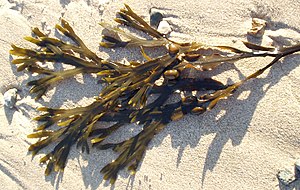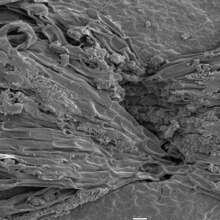Bladderwrack
| Bladderwrack | ||||||||||||
|---|---|---|---|---|---|---|---|---|---|---|---|---|

Bladderwrack ( Fucus vesiculosus ) |
||||||||||||
| Systematics | ||||||||||||
|
||||||||||||
| Scientific name | ||||||||||||
| Fucus vesiculosus | ||||||||||||
| L. |
The bladderwrack ( Fucus vesiculosus ) is a brown alga that is widespread in the North Atlantic and in the North and Baltic Seas . It is used, among other things, as a remedy. Its stocks in the Baltic Sea have decreased drastically in recent years.
description
The bladder wrack is a perennial large alga ( seaweed ) with a length of usually 10 to 30 cm (rarely longer). At the base it is connected to the ground with an adhesive plate. The leathery, rough, brown-green thallus is flattened, forked in one plane and traversed by a central rib. Characteristic and eponymous are the gas bubbles, which are arranged in pairs on both sides of the central rib and stand individually in the forks. They give the alga buoyancy in the water. The bladderwrack is covered by a layer of mucus that protects it from drying out at low tide.
Multiplication
Fucus species are diplomas without a generation change . In summer, swollen fruit bodies with gelatinous contents and warty surface are found at the ends of the thallus. These so-called receptacles contain conceptacles sunk in the shape of a jar, in which the gametes , egg cells and zoospores are formed. Male and female gametes are formed on different thalli in the bladder wrack ( diocyte ). When the tide rises, the sex cells emerge through the pore-like openings of the conceptacles. The egg cells secrete a pheromone (fucose rate) that attracts the sperm cells. The gametes are viable for a maximum of two hours and spread at most 2 to 10 meters. The fertilized zygote attaches itself and grows into a new diploid thallus.
The main ripening period extends from September to May. In June and July, the previous year's fruiting bodies degenerate and new recipes are created at the ends of the thallus.
Occurrence
The distribution area of the bladderwrack includes the coastal regions of the Atlantic . It is widespread from Northern Europe , the North Sea and the Baltic Sea to the Canary Islands and Morocco . In America it occurs from Canada to the Caribbean , it was also found on the coast of Brazil .
It grows in the surf zone and upper tidal zone on solid ground such as rocks, stones and wood.
On the German North Sea ( German Bight ) there are larger stocks, especially near Helgoland . In the Wadden Sea , bladderwrack is restricted to walls and mussel beds.
Decline in the Baltic Sea
On the German Baltic Sea coast , the bladderwrack was widespread on hard substrates up to the 20th century and was found at depths of 14 meters. An extreme decline has been observed here since 2004, particularly in the Mecklenburg Bay . Today you can only find a few individual Tange and only two stocks ( Wustrow and Salzhaff ), which are limited to the shallow water area up to a maximum of 2 m water depth. This decline could neither be explained by the salinity of the water nor by the availability of light or hard substrate. The reasons for this are assumed to be space competition with mussels , isopods or damage to the germ cells from oil pollution .
In the Bay of Kiel, too, most of the seaweed only grows at a depth of 2 meters, individual specimens can be found up to 3.5 meters deep. The growth limit potentially made possible by the light was determined here at a depth of 4 to 6 meters. It is believed that the growth of algae or perched barnacles shaded the seaweed and thus prevented penetration into greater depths.
ecology
The seaweed of the genus Idotea feed on the seaweed. The valley of the bladderwrack is populated by algae ( epiphytes ), such as Ceramium and Enteromorpha and Elachista fucicola . When seated animals occur polychaete ( Polydora ) and barnacles ( Balanus improvisus ) on the latter, the algae can almost completely cover especially in deeper water.
Common names
The bladder wrack was also popularly known as sea oak, sea oak, Bläretung, hump wrack, pig wrack, Klever, Steinklever or simply seaweed.
Systematics
The first description of Fucus vesiculosus was carried out in 1753 by Linnaeus in Species Plantarum , Vol 2, pp 1158. This type is the type species (lectotype) of the genus Fucus .
Synonyms of Fucus vesiculosus L. are Halidrys vesiculosus (L.) Stackhouse and Virsodes vesiculosum (L.) Kuntze. As more synonyms are Fucus axillary var. Subecostatus J.Agardh, Fucus axillary f. balticus (C.Agardh) Kjellman, Fucus balticus C.Agardh, Fucus divaricatus L., Fucus excisus Forsskål and Fucus inflatus L.
There is also a form of bladderwrack without gas bubbles, which occurs in places that are heavily exposed to the surf. The following varieties of Fucus vesiculosus are distinguished (Guiry in Algaebase, 2012):
- var. compressus Kjellman
- var. vadorum Areschoug
- var. linearis (Hudson) Kützing
- var. volubilis Goodenough & Woodward
- f. mytili (Nienburg) Nienhuis
use
Bladderwrack is widely used as an animal feed , food additive , in the fertilizer industry, for industrial applications and food processing. The harvest takes place exclusively from wild stocks. The stated harvest quantity (2005: 84 t) appears to be comparatively small compared to other types of seaweed .
ingredients
Bladderwrack contains up to 0.1 to 0.5% iodine , as well as bromine , beta-carotene , alginic acid , polyphenols with antibiotic effects, xanthophylls ( fucoxanthin ), polysaccharides and pectin-like mucilage . The mucus fucoidan has been shown to have an immune-stimulating effect on cancer . In addition, the bladder wrack has a high content of minerals and trace elements . Like all algae, it also accumulates arsenic and heavy metals such as lead and cadmium , which can be detected in the prepared products.
Medical use
The pharmaceutical industry uses bladder wrack to extract alginates . Bladderwrack is used in Ireland and France to make seaweed extract for cosmetic products. The dried algae are also used as seaweed baths in thalassotherapy .
Because of its high iodine content , bladder wrack has been used to treat goiter since the 17th century . In herbal medicine, it is used for hypothyroidism , hay fever , hardening of the arteries and psoriasis . In order to avoid an overdose of iodine, it must not be taken if the thyroid gland is overactive or during breastfeeding and pregnancy.
Since it was assumed that the active ingredients of the bladderwrack increase the basal metabolic rate, it has also been used to treat obesity since the mid-19th century .
Further use
Bladderwrack was used as a fertilizer in Scotland. Today it is used to extract micro-nutrients for animal feed . Local bladderwrack is also used as packaging material for the lobster breeding and transport of Pierwürmern used. A possible use as fuel ( renewable raw material ) is being investigated.
swell
- P. Kornmann, PH Sahling: Sea algae from Helgoland - Benthic green, brown and red algae. Biologische Anstalt Helgoland, Hamburg, 1983. ISSN 0017-9957 , pp. 162-165. (Sections description, propagation)
Individual evidence
- ↑ a b c Constanze Pehlke, Uwe Selig, Hendrik Schubert: Distribution and ecophysiology of Fucus stocks in the Mecklenburg Bay (southern Baltic coast). In: Rostock. Marine biologist Contribution ., Issue 20, pp. 123-142, 2008. PDF file
- ↑ a b c d Michael D. Guiry, GM Guiry: Fucus vesiculosus In: Algaebase - World-wide electronic publication, National University of Ireland, Galway , accessed on March 13, 2012.
- ↑ Wadden Sea Protection Station: Bladderwrack
- ↑ a b c Sven Rohde, Claas Hiebenthal, Martin Wahl, Rolf Karez, Kai Bischof: Decreased depth distribution of Fucus vesiculosus (Phaeophyceae) in the Western Baltic: effects of light deficiency and epibionts on growth and photosynthesis . In: European Journal of Phycology , Volume 43 (2), pp. 143-150, 2008. doi : 10.1080 / 09670260801901018
- ↑ P. Kornmann, PH Sahling: Sea algae from Helgoland - Benthic green, brown and red algae. Biological Institute Helgoland, Hamburg, 1983. ISSN 0017-9957 , p. 121
- ↑ a b c Bruno Vonarburg: Homeotany 4. Extravagant exotic species . 2nd edition, Georg Thieme, 2005. ISBN 3-8304-7228-5 , pp. 285-286 Google e-book
- ↑ Scientific marine studies. Sixth report of the commission for the scientific investigation of the German seas, in Kiel for the years 1882 to 1891.
- ^ Georg August Pritzel , Carl Jessen : The German folk names of plants. New contribution to the German linguistic treasure. Philipp Cohen, Hannover 1882, page 155. ( online ).
- ↑ a b Michael Guiry: The Seaweed Site: information on marine algae: Fucus vesiculosus , accessed on March 13, 2012.
- ↑ a b c d Dirk Schories, Uwe Selig, Christof Schygula: Use of marine organisms to reduce the nutrient load in the coastal waters on the German Baltic Sea coast - potentials and limits . In: Rostock. Marine biologist Contribution., Issue 15, pp. 87-104, 2006. PDF file
- ^ P Rupérez: Mineral content of edible marine seaweeds . In: Food Chemistry , Volume 79 (1), 2002, pp. 23-26 abstract
- ↑ Concepción Almela, M. Jesús Clemente, Dinoraz Vélez, Rosa Montoro: Total arsenic, inorganic arsenic, lead and cadmium contents in edible seaweed sold in Spain . In: Food and Chemical Toxicology , Volume 44, 2006, pp. 1904-1905 PDF file
- ^ A b c Gerhard Madaus : Textbook of Biological Remedies , 1938. On Henriettes Herbal Homepage
- ^ AB Ross, JM Jones, ML Kubacki, T. Bridgeman: Classification of macroalgae as fuel and its thermochemical behavior . In: Bioresource Technology , Volume 99 (14), 2008, pp. 6494-6504. Summary
Web links
- Interactions in an ecosystem: small changes - drastic consequences. In: klima-media.de - about the decline in bladderwrack in the Baltic Sea


